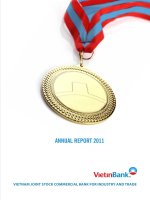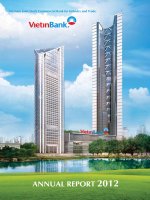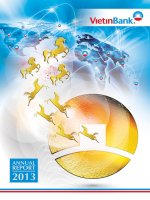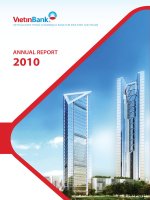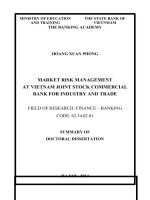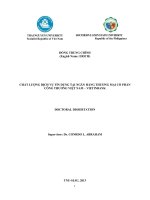Developing business strategies of Vietnam Commercial Joint Stock Bank for Industry and Trade - Cua Lo Branch (VietinBank Cua Lo) in the period of 2011-2015
Bạn đang xem bản rút gọn của tài liệu. Xem và tải ngay bản đầy đủ của tài liệu tại đây (35.11 MB, 68 trang )
REA
TAT
SSE
ASS
ESE
GRIGGS UNIVERSITY
GLOBAL ADVANCED MASTER OF BUSINESS ADMINISTRATION PROGRAM
CAPSTONE
DEVELOPING
PROJECT REPORT
BUSINESS STRATEGIES
OF VIETNAM COMMERCIAL
JOINT STOCK BANK
FOR INDUSTRY AND TRADE CUA LO BRANCH
(VIETINBANK CUA LO)
IN THE PERIOD OF 2011 - 2015
Group No.11
Student’s name:
Hanoi, 2011
1.
Ho Xuan Bay
2h
Nguyen Ngoc Thanh
Be
Ha Xuan Quang
4.
Nguyen Tuan Dung
GaiGcs)
(CÍ
UNIVERSITY
TABLE OF CONTENTS
là
402030 00:9)
p4...
6
1. General context, the necessity and the urgency of the research ....ccccccccccccecsseseees 6
2. Subject and purpose of the research ......c.ccccccescsssssscsesseseetsvsseseseevecesestavsveveseseevens 7
3. Research methodology ......c.ceccceccssessseesesescsesesssscscsvsvsssecsssvsusassvavsvaseatavavaveseseevees 7
4. Structure of the Capstome? ......cccccccccccscscscscssscscsvsvsvsvsvessssscatscssacavavavacavavevevavevevees 7
0.9409.002... .
8
THEORETICAL FOUNDATION OF......ccccccssssssssscscsesssscsesessscsesecesecacessssececacacees 8
BUSINESS STRATEGY ou... essesssssssssessssssesscsssesssscsssscssssssesseaesessecesussesesaesesecaeesecs 8
1.1. Business strategy
0. .eccescscscscssessscssscscscscsvsvscscacsvavavavavavavessueversssasussessesesesenes 8
1.1.1. Definition of business strategy .....c.ccccecccscccscsessesesesesescsvsvsvevscsveveseseseseesees 8
1.1.1.1. Different definitions of business strategy .....c.cccccssssesesssssscstsessssceceessess 8
1.1.1.2. Basic characteristics of business strategy ......c.ccccccccssscscsssscscsssssscsceeeeeees 9
1.1.2. The role of business strategy for an enterprise: ....c.c.ccccccceccssescessssseseseeeeeees 9
1.1.2.1. Focusing development ........c.c.ccccccccssscssssssesecsesescesssacscssuescssscsvssesesvevees 10
1.1.2.2. Three competitive strategies .......c.ccsccssccscseseseseseesessesesvessscesescsessesees 10
1.1.2.3. Competitive strategies for enterprises based on market share and
POSTEO; as.msss icnsonsinenwe nonnen ngurrvesine grote Wis HEED HREENASOEERD Sash fuhaenneanenees gang uy g3 v6 II
1.2. Process oŸ developing, stFaf€gy................
St tt 1E HE .......11111111 11x --neo 11
1.2.1. Defining the mission and Objectives .......c.cccccccssssssessscsscsesecesestsesscseseavees 12
1.2.2. Analyzing external environMent.......c.c.ccccccscsccecsssssssecsesvsessscscetscsesescans 12
1.2.3. Analyzing the enterprise’s internal environment .......c.c.cccccscscscsseescecseeees 12
1.2.4. Developing the strategic alternatives ..........cccccccccssesssssesesesseeseessetesestestenes 13
1.2.5. Analyzing and selecting strategies ........cccccscssscsssesesessssssescsesesesesvecececeees 14
1.3. Tools for strategic analysis .........ccccccccescssssssseeseesessssesescessesesescessvavavavavavevevevs 15
1.3.1. Using PEST Method to analyze macro factors .....cccccccsssssscscscecececeveceseeees 15
1.3.2. Using Michael Porter’s Five Forces of Competition to analyze micro
E000... .
15
1.3.3. Using EFE Matrix to analyze the Opportunities and Threats.................... 15
1.3.4. Using IFE Matrix to analyze the strengths and weaknesses.................... l6
1.3.5. Using SWOT Matrix to qualitatively analyzing the strategy................... 16
V0110.CapstoneProjectReport.Group11
2
GriGcs)
G conan
UNIVERSITY
1.3.6. Using QSPM to analyze and select J0...
17
KG -FJgy0.¡ẽ
7. g...H,HHLĂHAĂ)ĂL)L)L..Ỏ..
BUSINESS ENVIRONMENT SITUATIONS OF ....ccsscssssssssssssssssessccscssessesscscesee
VIETINBANK CUA LO uuu. ccscesssssssessesssscsscsesusscacsussussusacsussecsussssssssssasensenseeseses
2.1. General introduction... cecccccccccscccsessssessessesessesssessesseevessesseseessesteevereescescesce
19
19
19
19
2.1.1. Establishment and development history .....cccccccccccsscssecsesscssesssecsceseesceeeee 19
2.1.2. Organizational Chart .......c.c.cccccccscsssssssesssvssessssseseeseseaveseeveeveseesesceteececcecee, 20
2.1.3. Distribution network .....0.cccccccccccscessssestesessessesesessessstesseseereescereeteetescesces. 21
2.1.4. SerVice OfẨErings...........
t1 .....
He
.....e
.----cc 21
2.1.5. Business performance throughout the VGBTN chinh cnasis Wt ennsreneanmnneewonen
tres 23
2.2. Analysis of factors affecting the operations of VietinBank Cua Lo.............. 24
2.2.1. Macro environment_
(PEST model).........sa.....
1n ........ 24
2.2.1.1. Economic environment.........
-sss tt 23212115111
.....
11 EE .....
HE
...
24
2.2.1.2. Socio-cultura]l environment....
-s. .....
c sc St E21 .....
1S Ho
.....
28
2.2.1.3. Political and legal environment.........
52 2s.....
ST
HE
.....
.... 28
2.2.1.4, Natural environment .........cccccccccsssssesesessescssessesseesssteseessersesserceseeeescescess 30
2.2.1.5. Technological environmenI....
5s .....
2s 5 2S .....
2n
.....
30
2.2.2. Micro environment (industrial) — M. Porter’s Five Forces...................... 31
2.2.2.1. COmp€tÏOFS.......................
S1 TT 11211111 TT Hee
33
2.2.2.2. CUSEOI€TS...................
2.2.2.3. SUPpII€TS....................
HH
2. Q.2. HS
111111111 CEnx TH HT ng
nề
HH Hee
36
37
2.2.2.4. Potential competitOFS.--....
se ct nt E21 221221111211
....2 ....
neo
...
38
2.2.2.5. SuSEÏẨU€S....................
39
. tt TH E1 TH
HH Hee
2.2.3. Evaluation of opportunities and threats...........5s......
s1 SEEnnn
......
nen 40
2.2.4. External Factor Evaluation (EFE) Matrix ..ccccccccccccccccsscssesceseeseccescecesccceee. 42
2.3. Analysis of internal factors of VietinBank Cua Lo ceecceccecsccsccesccscescescescesceccess. 43
2.3.1. Human resources ......ecccceccescssssssssssvssesresssssavssessssssesssessesaversesserceteetescescess 43
2.3.2. Mark€ting.......................
5c: tt T112 5111121111 1 1n
Hee
43
2.3.3. Organizational StTUCtUF€......t .....
E111 2t E1 221112
.....
ne
...-ocs 44
2.3.4. Management capability.................... cecsceccssesvssecsessecsesessesssesseteeteeseecesceseess 45
V0110.CapstoneProjectReport.Group! 1
3
GriGcs)
GC
UNIVERSITY
1.3.6. Using QSPM to analyze and select strategies ...c.ccccccccescecccscessesceseeseesessee 17
3030 .75ẶẤ........
19
BUSINESS ENVIRONMENT SITUA TIONS OE......................
se cecet
.....-2
set sEecsee 19
VIETINBANK CUA LO..........
5° 5°....
5656 StESESEEEESEE
....
EEESEEEEEESEE
....
eEESEESSetEei
.2-reee 19
2.1. General Introductio.....................
-:-csctn 1112112111125 21 211
19
2.1.1. Establishment and development history ....c..ccccccccssccsesssessecsesssecsessecsceseee 19
2.1.2. Organizational Chart .......c.ccccccccsssssssesssssestestesesstesessesetsessessesteeteeseesesceseees 20
2.1.3. Distribution network .......c.ccccccccscsscssssssssestsstesesseseessesessessesusseeserterseseeseees 21
2.1.4. Service OffETINGS oc eecececcescssesscssessessesessscsesstssssessasestessesssstesveseerseeseseees 21
2.1.5. Business performance throughout the years ....cccccscccssssssssessesssecsessececeseee 23
2.2. Analysis of factors affecting the operations of VietinBank Cua Lo.............. 24
2.2.1. Macro environment
(PEST model).....ccccccccsccsssscessssesssesecsessececeveceescescees 24
2.2.1.1. Economic environment .......c.cccccscsssscssssesssssstesesvessesessesessesvessereeveceseees 24
2.2.1.2. Socio-cultural environMent.........cccccccscesssssscsseesesceseesssteseeseevescesescesecceses 28
2.2.1.3. Political and legal environment..........cccccccsssssssssescssesscesecseesecsesseseceseceees 28
2.2.1.4. Natural environment ..0......ccccccccccsscsssesssssssessessessesessessessesessseeseseceveeseevees 30
2.2.1.5. Technological environmenI.......
s5:......
s1 2v 2 21151112121
......
11 ...- 30
2.2.2. Micro environment (industrial) — M. Porter`s Five Forces.................s. 3]
2.2.2.1. COmp€fÏ{OFS...................
SG...
na
cố
2.2.2.3. SUPPÏI€TS...................
S2 2t 21 1 1110112112112 21 1E nen
33
CỐ aadi.
36
CỐ
0Q... vn HT
2.2.2.4. Potential CoImpetÏtOFS................
2.2.2.5. SuSEÏẨUẨŒS.....................
0111 n1 1c
HH
rrnere
.- tt St E121 21215111121 1E nen
Q0. 22t n1 1112112 1x TH
Hee
37
se 38
39
2.2.3. Evaluation of opportunities and threats...........
2. 2s ......
SE nen
... 40
2.2.4. External Factor Evaluation (EFE) Matrix............... Tnhh
42
2.3. Analysis of internal factors of VietinBank Cua Lo................ nen
43
2.3.1. Human r€SOUFC€S.......
5 St tt ....
12121111111....
11 EE TEEEnEnn
....
neo
.--
43
2.3.2. Mark€ting...................
43
.c. cccc 2t
n1 Hee
2.3.3. Organizational Structure .......c.cccccccsecesscscsssssstessseecessssesessevesceveresceveesececesees 44
2.3.4. Management capability 2.2... .cccccceccccsccsecscstssessesessssvesesseevesseesceseveecescees 45
V0110.CapstoneProjectReport.Group11
3
Z
GRIGGS
Global Advanced
MINDS
UNIVERSITY
JN THE
MAKING
3.4. Implementation progresses .......c.cccccccccscsssssssssssessstesesesseseeesesesveseeeseeveeevereees 64
3.5. Potential problems and solutions.........ccccscccccssessecsecsessesveseeseeseesesseesesseceeeveesee 65
CONCLUSION ........ HD.
66
BIBLIOGRAAPHIIES ..........5-5.....
Gv
.....
E1 HE.....
HE SE ...sen nesey 67
LIST OF TABLES AND FIGURES
Figure
Ll
‘Table 1.1
Tablel2
F.David’s Model of Strategic Management
| EFE Matrix
|IFEMatrix
1¬
-
Sóc
1¬
/
‘Table 1.3. |SWOTMatrix
:
‘Figure
1.4 | Quantitative Strategic Planning Matrix
| Figure 2.1
Figure 2.2
7
|
|
Organizational chart of VietinBank system
CO
Organizational Chart of VietinBank Cua Lo
|
_
|
Table2.1
| GDP growth rate of Vietnam and regions including Nghe An and
Cua Lo as a function of time
‘Table 2.2
Figure 2.3
| CPI of Nghe Anasafunctionoftime =~
| Summary of the macro factors influencing Vietinbank CuaLo _
‘Table 2.4
Comparison of Vietinbank branches in Nghe An
| Table 2.5
Comparison of Vietinbank Cua Lo with branches of
Vietcombank, BIDV, Agribank in Nghe An
| Figure 2.6
Summary of micro factors influencing Vietinbank Cua Lo
‘Table 2.7
| TheEFEMatixofVieinBankCualo
| Table 2.8
The IFE Matrix of VietinBank Cua Lo
-
_Table 2.9 _ | The SWOT Matrix of VietinBank Cua Lo
| igure 3.1
Internal - External Matrix (IE) of VietinBank Cua Lo
V1 10.CapstoneProjectReport.Group1 1
7
ˆ
Gigs)
@ Bi
UNIVERSITY
INTRODUCTION
1. General context, the necessity and the urgency of the research
The current context of global economic crisis such as debt ceiling issues in the
United
States and
many
European
countries have
strong impact
on the world’s
financial market.
Because of the fact that Vietnam gradually integrates into the world’s economy,
all the
fluctuations
of global
economy
also have
impacted
significantly
to the
economy of Vietnam. The banking system of Vietnam has faced many difficulties
since early 2001 till now.
Firstly, it is the force to reach the target of controlling the increasing inflation.
Banking system has to face liquidity difficulties, and it is difficult for every bank,
even the biggest ones, which are considered to be the market makers.
Secondly, if the interest rate was completely decided by the banks in the past,
this role, now, is transferred to customers, especially customers who hold a huge
amount of Vietnam Dong (VND). However, it is the state organizations that bargain
for interest rate the most. There is institution that organized bidding for capital cost
for deposit, and the winner would be the bank that offers the hi gher payment.
Thirdly,
it is merging
observing the low
resulted
ratio,
from
many
acquisition,
and
liquidity and weak
unhealthily
people
resale
acquisition
quick
have
growth,
asked
or announce
for,
in banking
financial
bankruptcy
For
situation of many
under-standard
in these
sector.
cases,
lending
years,
banks, which
and
to conduct
in order to make
many
low
safety
merging
the market
and
grow
strongly again, however, it has never happened since.
Fourthly, the foreign currency exchange market, after few years of chaotic rate
variability, it is now
settled down
behind that success
was
through series of decisive action. However,
the power
of the administration,
far
instead of tools with
regulating senses.
In this context, many banks have to develop or adjust their business strategies to
suit the market conditions. Vietnam Joint Stock Commercial Bank for Industry and
V0110.CapstoneProjectReport.Group 11
6
x
GRIGGS
_
G seals
UNIVERSITY
Trade - Cua Lo Branch (Vietinbank Cua Lo) is one of the best-operated branches in
the Vietin Bank system of Nghe An province and the whole Vietin Bank in general.
However,
in the volatile situation of the market and severe competition, Vietinbank
Cua Lo has to build their own business strategy to develop and compatible with the
strategy of the Bank’s overall system.
2. Subject and purpose of the research
- Subject of the research: Vietinbank - Cua Lo Branch
-
Purpose of the research: Developing business Strategies for Vietin Bank Cua
Lo in the period of 2011 — 2015 and propose solutions to make it become the
1“ ranking branch in the Vietinbank system.
3. Research methodology
- References: primary
Vietinbank
Cua
Lo,
and
secondary
Reports
data,
of the
data
People’s
of Vietinbank
Committee
Vietnam,
of Nghe
An
Province
-
Analyzing
technique:
IFE,
EFE,
SWOT
and
QSPM
matrices,
Michael
Porter’s five forces model of competition
4. Structure of the capstone:
Chapter 1: Rational foundation of business strategy
Chapter 2: Business Environment situations of Vietin Bank Cua Lo
Chapter 3: Business strategy selection and implementation solutions of VietinBank
~ Cua Lo for the period of 2011 - 2015.
V0110.CapstoneProjectReport.Group 11
7
Gries)
G2
UNIVERSITY
CHAPTER I
THEORETICAL FOUNDATION
BUSINESS STRATEGY
OF
1.1. Business strategy
1.1.1. Definition of business strategy
1.1.1.1. Different definitions of business strategy
Alain Threlart stated that "Strategy is the art that an enterprise uses to stand
against competition and win"
According
to M. Porter, "Strategy is the art of building solid competitive
advantages to defense"
For these reasons, the authors considered business strategy as a kind of art to
compete in the market and develop the enterprise.
According to the viewpoint of management, business strategy is a kind of plan:
- G. Arlleret stated that "Strategy is the determination of the roads and the
means to achieve the objectives defined by the policy"
- D. Bizrell et al defined strategy “as a general plan or direction that leads the
enterprise to the desired goal. It is the basis for the elaboration of the policies and
operational measures. "
-
Gluecl
integrated
plan
stated
that:
designed
to
"The
strategy
ensure
that
is
the
consistent,
comprehensive
enterprise’s
objectives
will
be
controlling
them
to
and
implemented.
According to the perspective of consistency:
- "Strategy
is the art of coordinating
activities
and
achieve long-term goals of the enterprise".
- Chandler defined that “strategy involves defining basic long-term goals of
the enterprise and in the same time choosing the mode or courses of actions and
allocate the necessary resources and implement those goals”
In an
enterprise:
"Strategy
is the art of organizational
design
aimed
to
facilitate long-term goals of the business and it has the relationship with the change
of business environment and competitiveness”.
V0110.CapstoneProjectReport.Group11
8
fo
GRIGGS
—_
G seni
UNIVERSITY
There are many definitions of Business strategy and each scholar has his own
approach and research method. However, it can be seen that all of these definitions
have a common
point “Business strategy involves competing to achieve business
goals”. In this capstone project, we synthetize and apply the concept of business
strategy through its characteristics and role.
1.1.1.2. Basic characteristics of business strategy
- Business strategy determines the basic objectives and business direction of the
enterprise in a specific period.
- The
orientation of the strategy
is to ensure the continuity and
firm of the
development in the constantly fluctuating business environment.
- Business strategy ensures to mobilize at het maximum
and combines
at the
optimal of extraction and use of enterprise resources at the present and in the future.
It also promotes the advantages and seizes the opportunity to competition.
- Business strategy an enterprise is reflected throughout a continuous process.
- Business
strategy always
peruses attacking thoughts
in order to win in the
marketplace.
- Business strategies are often built in a long period of time (3, 5 to 10 years).
1.1.2. The role of business strategy for an enterprise:
- Business strategy helps the enterprise to identify the purpose
direction as the guideline
for all manufacturing
and business
and its basic
activities of the
enterprise. Business strategy plays an orienting role in the long-term operation of
the business; it is a solid basis for the deployment of the operation. The lack of
strategy or when strategy is unclear or when there is no solid argument will make
the operation of the enterprise lost its way. There are many problems that can only
be seen in the immediate future but could not be associated with long-term plan and
cannot be seen as the main role in the whole activities of the enterprise.
- Business
business
strategy
opportunities,
helps
the
enterprise
and in the same
time take measures
and threats in the competitive marketplace.
V0110.CapstoneProjectReport.Group! 1
understand
9
and
take
advantage
to overcome
of
the risks
Về”
_
GRIGGS
G BS
UNIVERSITY
- Business strategy contributes to improve the efficient use of resources, enhance
the competitive position of the enterprise and ensure its sustainable development.
- Business strategy creates a solid basis for the proposal of policies and decisions
for suitable production that work in accordance with the fluctuation of the market. It
forms a solid basis for research and development, investment and development of
personnel training, expanding the market and product development. In fact, most of
the mistakes in investment, technology, markets come from developing strategy or
any problems in determining strategic objectives.
The foundation for success or failure depends on an important factor of how the
enterprise’s business strategy looks like.
1.1.2.1. Focusing development
This strategy is to improve the competitive position of enterprises in comparison
with the existing products based on enhancing marketing activities or changing the
existing market
strategy without
changing
the product.
It comes
in three main
strategies:
- Market
penetration:
increase
the market
share
for available
products
and
services available in the market through marketing activities.
- Market development: Provide products and services available in the new area.
- Product development: Increasing in sales, innovating in available products and
services.
1.1.2.2. Three competitive strategies
Cost-leading strategy
1.
Cost-leading strategy is driven by the overall action to provide products or
services that have the characteristics accepted by customers with the lowest cost
compare to all competitors.
Z,
Product differentiation
The
objective
of the
differentiation
strategy
is to gain
the
competitive
advantage for the enterprise through creating products (goods or services) that is
unique
in
some
features
to the
customers.
V0110.CapstoneProjectReport.Group 1
10
Enterprise
that
tries
to make
the
⁄
GRIGGS
S
G sonal
UNIVERSITY
difference to satisfy the customers in a way that no competitors cannot offer higher
price (a significantly price that is above the industry’s average)
Sy
Focus strategy
Focus strategy is the third among three generic competitive strategies. The
main difference with the two strategies is that it is directed to serve the needs of a
group of customers. A focus strategy will work on a specific market gap that can be
determined in terms of geography, customer type, or by product segment.
1.1.2.3. Competitive strategies for enterprises based on market share and
position:
Although they are in the same industry, but each enterprise has a different
market share position:
- The leader in the market
- The enterprises that challenge the market
- The enterprises that follow the market
- The enterprises that lurk in the market
1.2. Process of developing strategy
Figure 1.1 F.David Model of Strategic Management
\
External Factorz
Evaluating to find our
\
||
Setting up
'
long-term
Opportunitie: &Threatz
' | Setting up
Goal
‘ |
Specify
exizting
a
objectiv
e
and strategv
„ị
'
'
Review the
'
Company's
°
R
2|
Ägsiynmeuts
‘
:
Source | t
4
Internal Factors
Evaluating co find out
Strength: & Weaknezze:
4
Selecting
Strateøx
`
|
ge
4
:
DEVELOPING
STRATEGY
V0110.CapstoneProjectReport.Group] 1
'
‘
:
‘
Meazure and
Adjusting the level
of Implementation
|
Department
Policy
‘
:
4
IMPLEMENTING
STRATEGY
II
'
Distribution
i
q
`...
'
Goal
|
—|
"
EVALUATING
STRATEGY
GriGcs)
G alee
UNIVERSITY
The process of developing is the first stage in strategic management. There
are four steps in building up the strategy:
1.2.1. Defining the mission and objectives
Vision: Claims of enterprise on their position in business environment in a
certain period of time — is guidelines for company’s
action in all the times and
circumstances.
Mission: The mission of an organization is actually its business purpose, its
reason
for the establishment,
organization
survival
answer the question:
and
What
development.
is the reason
Business
mission
of an
for an organization to be
established and exist?
Objective:
The
objective
is
the
state,
the
specific
organization wants to achieve over a period of time. Most
results
that
the
organizations pursue
profit and goals of excellence and leading position. The second objective is the goal
that the organization thinks it is necessary to achieve remarkable capacity.
1.2.2. Analyzing external environment
They are the elements, these forces and the alternatives that locate outside that
the enterprise that the administrators could not control, but they have strong effect
on the operation and performance of the enterprise.
The environment of an enterprise includes:
+ Macro-environment (general environment) includes factors like the economy,
politics, legislation, technology, culture and society, nature.
+ Micro-environment
(specific environment)
includes
factors like customers,
suppliers, industry competitors, potential competitors, replacement products.
The
conditions
aim
here
to clarify
is to
identify
and
the environmental
understand
factors
the
related
environmental
that are likely to influence
the
decisions of the enterprise.
Evaluating the opportunities and challenges from the external environment
that affect the enterprise will allow the enterprise to build a suitable business task
and set out clear policies to achieve the goals.
1.2.3. Analyzing the enterprise’s internal environment
V0110.CapstoneProjectReport.Group11
12
GriGcs)
G2
UNIVERSITY
Analyzing the internal environment of the enterprise in order to find out the
strengths and weaknesses, ways to achieve competitive advantage, and the role of
different capacities, resources and capacity to build and maintain sustainable
competitive advantage for the business.
The internal environment is analyzed based on functional activities such as
human resources, technical infrastructure, technology and finance.
1.2.4. Developing the strategic alternatives
After analyzing the factors of the macroeconomic and business environment,
the
enterprise
environment,
often
has
to
identify
opportunities
the strengths and weaknesses
and
risks
from
external
from the internal environment of the
enterprise used as the foundation for developing orientation and strategic plan. The
main technique that used is analyzing the strengths, weaknesses, opportunities and
threats. (SWOT Matrix)
SWOT analysis provides useful information for connecting the resources and
capabilities of the enterprise within the competitive environment that it operates. It
is also the tool to set up and selecting the strategy. SWOT
Matrix is a method of
analyzing the strengths, weaknesses, opportunities and threats.
Analyzing SWOT
evaluating
SWOT
the position
is suitable
planning,
Matrix provides tools for strategic analyzing, review and
and the orientation
for working
strategy
of an enterprise
and analyzing
development,
in groups,
competitor
or a business
it is used
evaluation,
plan.
in business
marketing,
product
development and services.
SWOT
Analysis is the assessment of data held by a SWOT
to understand,
SWOT
analysis
present,
is an extension
can
be
used
discuss,
and
apply.
of two-dimensional
for
any
decision
and
Four-dimensional
"strengths"
the
SWOT
and
model in order
evaluation
"weakness".
model
allows
of the
SWOT
positive
thinking, beyond any framework of habit or instinct. When analyzing SWOT,
we
need to identify clearly the purpose of the target, and then we can expect others to
contribute to the analysis process. The people who see the results of the analysis
V0110.CapstoneProjectReport.Group11
13
GriGcs)
@ VN
UNIVERSITY
could understand the purpose of analytical methods, evaluation and the relationship
between the SWOT factors. This is a simple method in business that is easy to apply
and can be used in many areas of business.
1.2.5. Analyzing and selecting strategies
When choosing a strategy, an enterprise should consider a number of factors
that affect the strategic choices. These factors include both objective and subjective
factors, namely the strengths of the industry and enterprises, strategic objective of
the enterprise,
leaders’
attitude
in the enterprise,
financial
sources,
ability
and
capacity of the managers, the reflection of the subjects and the deadline.
Some foundations for selecting strategies
- The
power
of the enterprise
and
the
industry
in comparison
to other
competitors that may influence the strategic choices.
- Tasks and objectives: The system of goals that the board of directors has
given that could directly affect the choice of strategy. The point here is to choose
the appropriate strategy for the target and duties of enterprises rather than only the
profit or growth.
- The viewpoint of the executive director has a direct effect the choice of the
strategy, especially the attitude of the executives towards risk.
- Financial capacity of the enterprise also has the influence and some of them
even put pressure on the strategy selection. The bigger and convertible the capital
an enterprise has, the easier for it to pursue opportunities, but some have to give up
due to insufficient financial capacity.
- Capabilities
and
qualifications
of business
administration
staff of the
enterprise also govern the sclection of strategy. This factor plays a more or less a
role in the implementation of the strategies and to the success of a strategy.
- The
time
factor:
The
success
of a strategy
identifying the right time for implementation.
V0110.CapstoneProjectReport.Group 11
14
may
depend
heavily
on
GriGes)
G sala
UNIVERSITY
- Results of the current strategic review
of your business:
Identifying the
exact current strategy of the enterprise as a basis for choosing the new strategy and
confirm the current strategy.
1.3. Tools for strategic analysis
1.3.1. Using PEST Method to analyze macro factors
PEST studies the impacts of the factors in the macro environment.
Those
factors are:
Political factors
Economic factors
Socio-cultural factors
Technological factors
These four factors have a direct impact to the economy. Other than that, there
are natural conditions which are external factors of the enterprise and the industry
which must take the effects it provides as objective element. The enterprises will
base on these impacts to create suitable policies and business activities accordingly.
1.3.2. Using Michael Porter’s Five Forces of Competition to analyze micro
factors
Porter’s Five Forces Model was first printed in the Harvard Business Review
in 1979 with the content is to understand the factors that create profits in business. It
is called Porter’s Five Forces Model and considered as a useful and effective tool to
learn about the source of profits. More importantly, this model offers competitive
strategies for the enterprise to maintain and increase business profitability.
1.3.3. Using EFE Matrix to analyze the Opportunities and Threats
The specialists have come up with the EFE Matrix to evaluate the external
factors
V0110.CapstoneProjectReport.Group] 1
15
Global Advanced
MINDS
Table
1.1:
EFE
IN
THE
MAKING
Matrix
External Factors
Weigh
Rating
Weighted Score
(1)
(2)
(3)
(4)
List all the external
Grading from 0 to
1 = low reaction
factors of the
1, the higher the
2 = average reaction
enterprise
weight, the more
3 = above average
(international, local,
important the
reaction
industry)
factor
4 = good reaction
Total = 1
(4) = (2)x(3)
Total = X
1.3.4. Using IFE Matrix to analyze the strengths and weaknesses
Specialists have come up with the IFE Matrix to evaluate the internal factors:
Table 1.2: IFE Matrix
Internal Factors
Weight
(1)
Listing all the
internal factors
Rating
Weighted Score
(3)
(4)
(2)
Grading from 0 to 1,
1 = weakest point
(4) = (2)x(3)
| the higher the weight, | 2 = weak
of the enterprise | the more important
3 = strong
the factor
4 = strongest point
Total = 1
Total = Y
1.3.5. Using SWOT Matrix to qualitatively analyzing the strategy
Analyzing the Strengths - Weaknesses — Opportunities — Threats
SWOT stands for Strengths (S), Weaknesses (W), Opportunities (O) and Threats
(T). This is a very useful matrix that helps us to study an issue or make decision in
managing or organizing in business.
Table
Internal Environment
1.3:
SWOT
Matrix
Strengths (S)
Weaknesses (W)
List all the important
List all the important
External
strengths from the Table of
weaknesses from the Table of
Environment
internal factors of the
internal factors of the
of the enterprise
enterprise
enterprise
of the enterprise
V0110.CapstoneProjectReport.Group1 1
16
Global Advanced
MINDS IN THE MAKING
Opportunities (O)
Combination S-O
Combination W-O
List all the important
Make advantage of the
Make use of external
opportunities from the
enterprise’s strengths to
opportunities to overcome the
Table of external factors
develop the opportunities in
internal weaknesses of the
of the enterprise
the external environment
enterprise
Threats (T)
Combination S-T
Combination WE.
List all the important
Make use of the internal
threats from the Table of
strengths to reduce the
strategies, which iis overcoming
external factors of the
impact of external threats
weaknesses and reduce or
Combination of ‘protecting
enterprise
..
avoid external threats
S-O Strategy: using the strengths of the enterprise to make advantages of
the external opportunities
W-O
Strategy:
overcome
the weaknesses
to make
advantage
of external
opportunities
S-T Strategy: using the strengths of the enterprise to deal with the external
threats
W-T Strategy: overcome the weaknesses to reduce the external threats
1.3.6. Using QSPM to analyze and select strategies
Quantitative Strategic Planning Matrix - QSPM uses the in-put data from the
above analysis (mentioned in the previous chapters) to help strategists subjectively
determine which strategy in a alternative set of strategies is the most appropriate for
the company to pursue in order to successfully accomplish its objectives.
Table 1.4 Quantitative Strategic Planning Matrix
Rating
(2)
Alternatives
Alternative | Alternative | Alternative
l
A
2
B
A
3
B
A
B
Internal factors
External factors
Total
¥0110.CapstoneProjectReport.Group11
S
17
S
S
GriGcs)
(GF mee
UNIVERSITY
In principle, a QSPM can include any group of strategies in an alternative set
of strategies which include any strategy; but only strategies in the same group can
be evaluated and compared. These groups of strategies are different and a QSPM
can only evaluate strategies in the same group.
It should be noted that QSPM
shows the comparative attractiveness of the
alternative strategies; and more importantly it provides subjective bases to consider
and determine
the most appropriate product
strategy. However,
QSPM
also has
some limitations and it must have certain conditions to be used in practice. One of
the biggest drawbacks is that in the process of developing the matrix, intuitive
judgement is required to give the factors the attractiveness score - although based on
the
environmental
analysis
effectively use QSPM,
consensus
on
each
information
conducted
before.
Therefore,
in order to
strategists are required to discuss thoroughly and reach a
number
in
the
matrix
by
adding
scoring
bases
in
the
attractiveness score column.
Strategy selection is the final determinant step of the strategy development
and
also the first step in the strategy
implementation
process.
Developing
and
selecting strategies can identify steps required to have a feasible business strategy.
However, to be successful in the marketplace, selecting the appropriate strategy is
essential and crucial. And with the selected strategy, the company must implement
it
effectively.
This
is
a
critical
stage
to
expectations into reality.
V0110.CapstoneProjectReport.Group11
18
translate
the
company’s
strategic
GriGcs)
Ga
UNIVERSITY
CHAPTER II
BUSINESS ENVIRONMENT SITUATIONS OF
VIETINBANK CUA LO
In this
chapter,
the
report
concentrates
on presenting
the current
business
environment situations of Vietinbank Cua Lo. This part also analyzes the external
and
internal
environment
of Vietinbank
Cua
Lo
directly
affecting
the business
performance and evaluates the actual opportunities, challenges as well as strengths
and
weaknesses
of Vietinbank
Cua
Lo
in
order
to
formulate
the
appropriate
business strategies for the period 2011 -2015.
2.1. General introduction
2.1.1. Establishment and development history
The Cua Lo branch of Vietnam Joint Stock Commercial Bank for Industry and
Trade (VietinBank Cua Lo) was previously a second-level branch of Nghe An bank
of Industry and Trade. On August
IŸ 2006, VietinBank Cua Lo was upgraded into
one of the first-level branches of Vietnam Bank of Industry and Trade (VietinBank),
according to the decree No. 197/QD-HDQT-NHCT1
on July 4" 2006.
The responsibilities of VietinBank Cua Lo include: trading of currencies, credit,
banking services and other activities such as trading of foreign currencies and gold;
financial consultancy;
commercial
commission
and receiving commission;
bank related fields; providing
being a agency
in
insurance services in accordance with
legal requirements; providing services of preserving valuable possessions, valuable
documents; leasing lockers; mortgage and other services in accordance to with the
legal regulations of Vietnam.
In the period of establishment, net balance of VietinBank Cua Lo was 35,000
million Vietnam dong and the capital raised was 26,000 million Vietnam dong; the
total number of staffs was 35, the head office was located at No.190 Binh Minh
Street, Cua Lo town, Nghe An, with 5 departments and sections at the head office
(including Administration, Accounting, Customer Service, Currency Treasury, Risk
Management)
V0110.CapstoneProjectReport.Group11
19
Gries)
CG Di
UNIVERSITY
2.1.2. Organizational chart
Figure 2.1: Organizational chart of VietinBank system
f
ETT)
F
Hee
i
a
i
1st level
Seance
¬
;
Underlying
re
bề
a
:
Reprcsentative
ratio
Career Tìm Units
Mission
Being a
leading financial - banking group of Vietnam with versatile operations,
the bank’s mission is to provide customers with international standard products and
services in order to improve the value of life.
Vision
To
become
a leading,
modern
and
effective
financial
- banking
group
in
Vietnam and in the world
Core values
- All activities are customer-oriented;
- Dynamic, creative, professional, dedicated, transparent and modern;
- The employees are encouraged to strive, work hard and contribute - They have
the right to be rewarded
according
individual
-
contributions
to the quality,
Outstanding
and
results
and
hard-working
appropriately honoured
Business philosophy
- Security, efficiency, sustainability and international standards;
- Solidarity, cooperation, sharing and social responsibility;
- The prosperity of customers is the success of VietinBank.
Slogan: Improving the value of life.
V0110.CapstoneProjectReport.Group1 1
20
effectiveness
individuals
of
are

